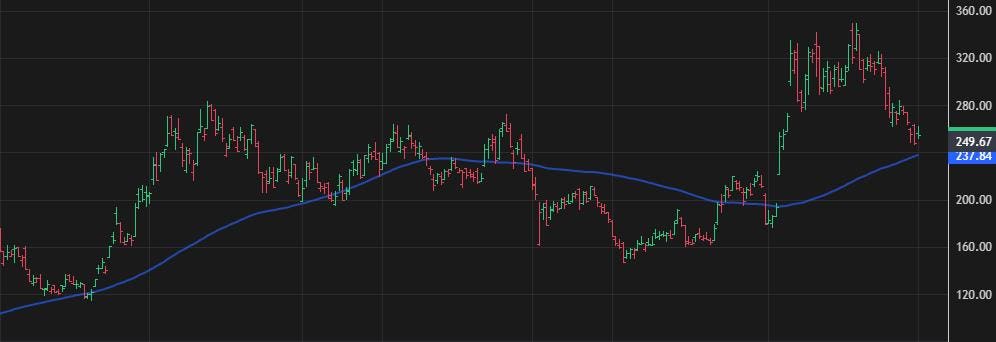Coinbase Global (COIN), a leading cryptocurrency exchange platform, has experienced a significant price decline in recent weeks, shedding 17.2% of its value over the past month. This downturn has pulled the stock considerably away from its four-year high of $349.75 achieved in December 2023. However, despite this recent bearish trend, there are indications that COIN’s decline may be temporary, as the stock is approaching a historically bullish trendline, suggesting a potential reversal in its fortunes.
Quantitative analysis reveals that COIN is currently trading within one standard deviation of its 80-day moving average. This technical indicator suggests a potential turning point for the stock, as similar instances in the past three years have consistently resulted in positive price action for COIN. Historical data indicates that following four previous occasions where COIN approached its 80-day moving average in this manner, the stock experienced an average gain of 23.4% one month later, showcasing a strong bullish pattern. This historical precedent provides a basis for optimism, suggesting that COIN’s current pullback may be a buying opportunity for investors.
Further reinforcing this positive outlook is COIN’s recent price action. The stock has already begun to rebound, demonstrating a 4.5% increase, trading at $259.50 and poised to break its four-day losing streak. If history repeats itself, and COIN experiences a similar 23.4% increase from its current price level, it would reach approximately $320.22, indicating a substantial potential upside. This potential for significant gains, coupled with the historical trendline support, presents a compelling case for investors considering entering or adding to their COIN positions.
Despite this positive technical outlook and impressive year-over-year growth of 69.5%, analyst sentiment towards COIN remains predominantly bearish. A significant portion of covering analysts, 13 out of 23, maintain a “hold” rating on the stock, reflecting a cautious stance. Further emphasizing this negative sentiment, one analyst has even assigned a “strong sell” rating to COIN, indicating a belief that the stock is overvalued and likely to experience further decline. This disconnect between the technical indicators and analyst sentiment creates an intriguing dynamic, suggesting a potential mispricing of the stock.
Short-term options traders also exhibit a pessimistic view on COIN, as evidenced by the Schaeffer’s put/call open interest ratio (SOIR) of 0.79. This metric, which measures the relative volume of put options (bets on price decline) versus call options (bets on price increase), indicates a higher than usual level of bearish sentiment among options traders. The SOIR currently sits higher than 80% of readings from the past 12 months, suggesting a significant skew towards bearish bets on COIN. However, this pervasive pessimism could also be interpreted as a contrarian indicator, suggesting that the stock may be oversold and ripe for a rebound. If this pessimism unwinds, potentially triggered by positive news or a sustained price increase, it could create a significant buying pressure, pushing COIN higher.
Given COIN’s historical tendency to exceed volatility expectations, now may present a favorable opportunity to capitalize on the stock’s recent dip using options. COIN’s Schaeffer’s Volatility Scorecard (SVS) of 82 out of 100 reveals that the stock has consistently experienced price swings larger than those implied by options prices over the past year. This elevated SVS suggests that options on COIN are currently underpricing the stock’s potential for volatility, creating a potential opportunity for options buyers. Investors who anticipate a significant price move in either direction could potentially profit by purchasing options, as the actual price movement may exceed the implied volatility priced into the options. This approach allows traders to leverage their capital and potentially generate higher returns compared to simply buying or selling the stock directly. However, it’s crucial to remember that options trading involves inherent risks, and investors should carefully consider their risk tolerance before implementing any options strategies.










